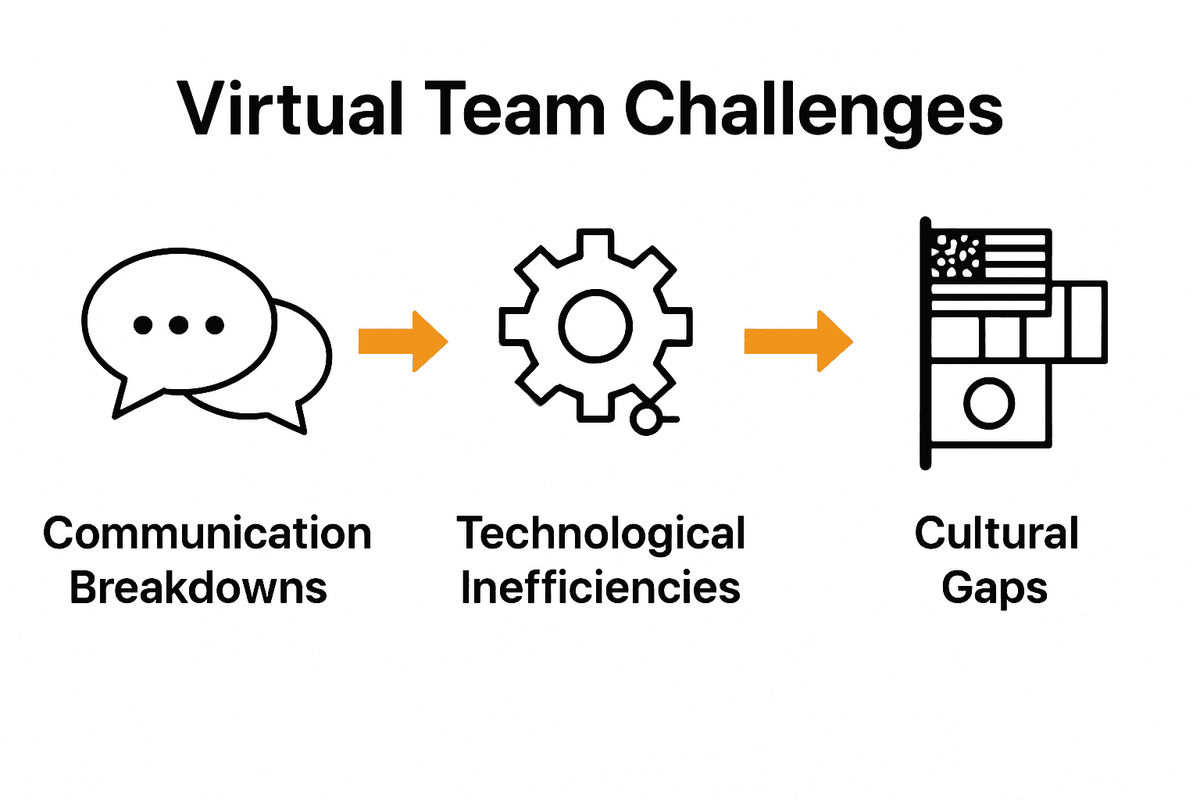Complete Guide to Virtual Team Building Strategies
November 8, 2025

Over 60 percent of global companies now rely on remote teams to keep business running smoothly. Managing these virtual groups comes with unique challenges, especially when building trust and maintaining collaboration from a distance. By understanding what makes virtual team building work, you can strengthen connections, boost engagement, and turn online teamwork into real results.
Table of Contents
- Defining Virtual Team Building and Its Core Concepts
- Types of Virtual Team Activities and Formats
- Key Tools and Platforms for Remote Engagement
- Best Practices for Facilitating Online Collaboration
- Common Mistakes and How to Avoid Them
Key Takeaways
| Point | Details |
|---|---|
| Technology Integration | Leverage collaborative digital tools to enhance communication and bridge gaps in virtual teams. |
| Trust and Connection | Focus on building trust and personal connections among team members to foster a cohesive remote environment. |
| Clear Communication Protocols | Establish and maintain explicit communication guidelines to avoid misunderstandings and facilitate effective interactions. |
| Avoid Common Pitfalls | Proactively address communication breakdowns, technology inefficiencies, and cultural gaps to improve virtual team performance. |
Defining Virtual Team Building and Its Core Concepts
Virtual team building represents a strategic approach to fostering collaboration and connection among remote workers using digital communication technologies. Virtual teams are geographically dispersed groups of professionals who collaborate through electronic platforms, relying on technology to bridge physical distances and achieve organizational objectives.
According to Wikipedia, a virtual team consists of individuals working together remotely using communication technologies like email, instant messaging, and video conferencing. These teams fundamentally depend on electronic communication channels to complete tasks, which requires specialized leadership strategies and technological proficiency to overcome collaboration challenges.
The core concepts of virtual team building revolve around several key elements:
- Technology Integration: Utilizing collaborative digital tools that enable seamless communication
- Trust Building: Creating opportunities for personal connections despite physical separation
- Clear Communication Protocols: Establishing consistent interaction guidelines and expectations
- Performance Measurement: Developing transparent metrics for tracking individual and collective achievements
Virtual collaboration aims to replicate the information transfer of traditional face-to-face interactions through verbal, visual, written, and digital communication channels. Wikipedia notes that while these methods are powerful, they can sometimes struggle to convey nuanced information as effectively as in-person meetings. Successful virtual team building requires intentional design, robust technological infrastructure, and a commitment to maintaining human connections in a digital environment.
Understanding these foundational principles helps organizations create more resilient, adaptive, and engaged remote workforces. By recognizing the unique dynamics of virtual teams, managers can develop targeted strategies that transform geographical dispersion from a potential limitation into a strategic advantage. Learn more about effective approaches in our guide to successful team-building tips.
Types of Virtual Team Activities and Formats
Virtual team building activities have evolved to create meaningful connections across digital platforms, offering diverse approaches to engage remote teams and foster collaboration. These activities are not just about entertainment but serve critical purposes in maintaining team cohesion, communication, and organizational culture.
According to Indeed, online team-building activities span a wide range of engaging formats designed to enhance social relations and boost morale. These activities typically fall into several strategic categories:
Interactive Game-Based Formats:
- Trivia Competitions: Quick, engaging knowledge-based challenges
- Virtual Escape Rooms: Collaborative problem-solving experiences
- Online Quiz Tournaments: Skill-testing group activities
Social Connection Activities:
- Virtual Lunch Dates: Informal networking opportunities
- Remote Coffee Breaks: Casual conversation platforms
- Storytelling Sessions: Personal sharing and team bonding
Skill Development Workshops:
- Digital Collaborative Workshops: Learning-focused group interactions
- Online Training Sessions: Professional development opportunities
- Cross-Functional Skill Exchanges: Knowledge sharing across teams
Physical wellness and interactive experiences also play a significant role in virtual team building. Online workout classes, group fitness challenges, and wellness-oriented activities help teams connect beyond traditional work boundaries. These approaches recognize that team building transcends mere task completion and focuses on holistic employee engagement.
When designing virtual team activities, organizations must consider factors like team size, technological accessibility, and participant interests. The goal is creating inclusive experiences that feel natural and genuinely enjoyable.
 For more creative ideas, explore our 8 engaging online team building games that can transform remote interactions into meaningful team-strengthening moments.
For more creative ideas, explore our 8 engaging online team building games that can transform remote interactions into meaningful team-strengthening moments.
Key Tools and Platforms for Remote Engagement
Remote team engagement requires sophisticated digital platforms that seamlessly bridge communication gaps and create interactive experiences. Virtual collaboration tools have become essential infrastructure for modern organizations, enabling teams to connect, collaborate, and maintain productivity across geographical boundaries.
According to StarLeaf, virtual team-building activities leverage platforms like Zoom and Microsoft Teams to conduct interactive games, decision-making simulations, and problem-solving challenges. These platforms promote critical workplace dynamics such as communication, collaboration, and team cohesion among remote employees.
Key Collaboration Platforms:
- Video Conferencing Tools
- Zoom
- Microsoft Teams
- Google Meet
- Webex
- Project Management Systems
- Slack
- Asana
- Trello
- Monday.com
- Interactive Collaboration Spaces
- Miro
- Figma
- Google Workspace
- Mural
Resolution highlights that collaborative online workshops utilizing tools like Miro, Figma, and Google Workspace facilitate structured sessions where team members can work together on projects, learn new skills, and solve problems. These platforms enhance remote engagement by creating shared digital workspaces that feel intuitive and interactive.
Effective tool selection depends on specific team needs, technological comfort, and organizational goals. Managers should prioritize platforms offering seamless integration, user-friendly interfaces, and robust features that support both professional collaboration and team-building activities. For comprehensive insights into selecting the right tools, explore our best team building platforms comparison to make informed decisions about your remote engagement strategy.
Best Practices for Facilitating Online Collaboration
Online collaboration represents a complex dance of communication, technology, and interpersonal dynamics that requires intentional strategy and thoughtful execution. Virtual teams demand a nuanced approach that transcends traditional workplace interactions, focusing on creating meaningful connections and productive workflows across digital platforms.
According to Wikipedia, effective virtual teams require clear norms for technology use, careful selection of communication tools, and strategies to mitigate challenges like reduced nonverbal cues and differences in communication timing. Establishing common ground and fostering inclusion become critical success factors in remote collaboration environments.
Key Collaboration Best Practices:
- Communication Clarity
- Establish explicit communication protocols
- Define response time expectations
- Use multiple communication channels
- Technology Integration
- Select user-friendly collaboration platforms
- Provide comprehensive technological training
- Ensure accessibility across different devices
- Team Engagement
- Schedule regular virtual check-ins
- Create opportunities for informal interactions
- Recognize and celebrate team achievements
Sally.io emphasizes that successful virtual team-building requires interactive activities that promote problem-solving skills and intensive collaboration. These activities should mirror the skills needed in daily remote work, creating opportunities for team members to develop trust, communicate effectively, and work collectively towards shared objectives.
Managerial success in online collaboration hinges on creating a supportive, inclusive environment that balances structured work processes with genuine human connection. By implementing thoughtful strategies and remaining flexible, teams can transform potential remote work challenges into opportunities for innovation and deeper understanding. For additional insights into enhancing team dynamics, explore our guide on managing team collaboration and discover advanced techniques for remote team success.
Common Mistakes and How to Avoid Them
Virtual team collaboration is fraught with potential pitfalls that can derail productivity and team morale. Remote work challenges require proactive strategies and a nuanced understanding of digital communication dynamics to prevent common organizational missteps that can compromise team effectiveness.
According to Wikipedia, common mistakes in virtual teams frequently stem from three critical areas: lack of clear communication norms, inadequate technology selection, and failure to establish common ground among team members. These foundational weaknesses can create significant barriers to successful remote collaboration.
Top Virtual Team Collaboration Mistakes:
- Communication Breakdowns
- Inconsistent messaging
- Unclear expectations
- Over-reliance on single communication channel
- Technological Inefficiencies
- Poor platform selection
- Inadequate technical training
- Incompatible communication tools
- Cultural and Interpersonal Gaps
- Minimal team bonding
- Limited understanding of diverse work styles
- Lack of empathy and context
StarLeaf emphasizes that avoiding virtual team-building pitfalls requires carefully selecting activities aligned with team goals, ensuring active participation, and creating an inclusive environment. This approach helps mitigate challenges like time zone differences and varying technological proficiencies that can fragment team cohesion.
Successful virtual teams transform potential obstacles into opportunities by implementing robust communication protocols, investing in comprehensive technological training, and maintaining a flexible, empathetic approach to remote collaboration. By anticipating and addressing these common mistakes, organizations can create resilient, high-performing virtual teams that transcend geographical boundaries. For deeper insights into navigating these challenges, explore our top team building exercises for better workplace collaboration.

Strengthen Your Virtual Teams with Customized Interactive Games
Building trust and clear communication in remote teams is more critical than ever. If your virtual team struggles with engagement or finding ways to connect beyond work tasks, personalized quiz experiences can spark collaboration and fun. By tapping into game-based activities inspired by popular formats, you can overcome common challenges like communication breakdowns and lack of interpersonal bonding discussed in the guide to virtual team building strategies.

Discover how to bring your remote teams closer with tailored quizzes that blend entertainment with development. Whether you want to energize your next online meeting or enhance team cohesion, explore our flexible solutions crafted for corporate teams. Start improving communication, trust, and participation today on quizado.com or browse our work-related team building activities for ideas that fit your team's unique culture.
Frequently Asked Questions
What is virtual team building?
Virtual team building is a strategic approach to fostering collaboration and connection among remote workers using digital communication technologies to achieve organizational objectives.
What are effective activities for virtual team building?
Effective virtual team building activities include trivia competitions, virtual escape rooms, remote coffee breaks, storytelling sessions, and digital collaborative workshops focused on skill development.
What tools are essential for virtual team collaboration?
Key tools for virtual team collaboration include video conferencing platforms like Zoom and Microsoft Teams, project management systems like Slack and Asana, and interactive collaboration spaces like Miro and Google Workspace.
What are common mistakes in virtual team collaboration?
Common mistakes in virtual team collaboration include communication breakdowns, selecting inadequate technology, and failing to establish common ground among team members. These pitfalls can hinder productivity and team morale.




